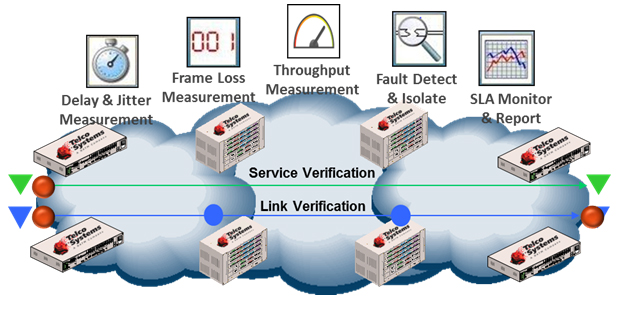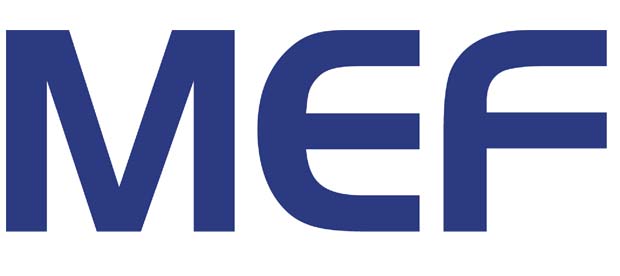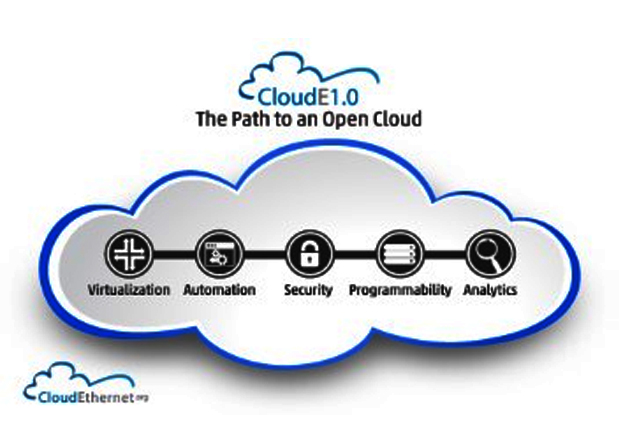Service providers want better management and control of their networks to support new revenue generating services. Operations, administration and maintenance (OAM) functions must be part of the network if they are to deliver Carrier Ethernet services with the assurance of committed levels of SLA and QoS. What are the relevant OAM standards and how do they help improve business services, cloud based services and backhaul network service delivery to allow better service verification and management?
It is not enough for service providers simply to provide dumb pipe connectivity, allowing others to exploit their network to make lucrative business from customized OTT services. So SPs expand their business strategy and increasingly offer their own value added services to increase their return on the massive infrastructure investment. Many diverse services are now sharing the network and it is now the network owners’ responsibility to meet appropriate service level agreements (SLAs) and ensure a quality of experience (QoE) that will both attract repeat sales and build market reputation.
One size, however, does not fit all. Business services, mobile backhaul, inter-connect and cloud services both to end-users and other providers each have different requirements and expected availability, resiliency and SLA demands. So providers need cost effective solutions that support multiple business services as diverse and demanding as tele-presence, cloud computing, and remote backup – each requiring their own SLAs to include factors such as delay, jitter and packet loss. Their customers – including business services, cloud providers and mobile operators – also want increasingly stringent SLAs, with service assurance at least as good as what they were used to in SDH/SONET networks.
So, packet-based networks need to match the high uptime and guaranteed service levels of legacy voice networks, but managing the stream of packets carrying various types of traffic end-to-end across diverse networks is a growing challenge. Legacy management tools designed for LAN-type Ethernet networks are simply not adequate for today’s demands – failing to address the more complex security, performance and access control issues arising across the multiple administrative domains of wide area networks (WANs) and their access networks.
As a result, operations, administration and maintenance (OAM) tools are becoming an essential part of every end-to-end solution. They allow SPs to control their networks and services, making for easier, faster remote troubleshooting and improved real-time alarms and reporting.
DIFFERENTIATING A CARRIER-GRADE SERVICE OFFERING
Why should any customer choose your service over that of your competitors? For a start it is necessary to provide services that help the customer to operate profitably and that includes saving them money – so ease of installation and deployment, and end-to-end management are important, to allow for fast and simple troubleshooting. Providers also seek to differentiate their offerings in many ways, but the really important feature is not so much added functionality as how well each function is implemented and the quality of experience it providers the end-users.
Firstly, there must be some way to measure and quantify Carrier Ethernet service parameters to be sure they meet the required availability, reliability and performance standards for end-to-end voice, video, data or converged services. You cannot guarantee levels and qualities of service without being able to measure and assess the capabilities of equipment at all points in the infrastructure. It may also be necessary to provide real-time monitoring – for example when providing backhaul for a mobile operator. So OAM tools are needed to help the provider to define service levels across the network, provision the service, and accurately monitor the service performance to determine if the agreed SLA is being met.
Next comes ease of deployment – nothing puts people off new technologies more than costly, time-consuming installation procedures, and nothing degrades ongoing maintenance operations more than the inability to isolate and correct faults quickly and easily without truck rolls. So network interface devices with built in OAM capability combined with a simple to use service management system will soon repay the investment in terms of time and labour savings.
Once the necessary network elements have been provisioned for a service, it is then essential to validate the service provision. This requires a decision on what sort of test heads to use. External test heads will disrupt existing services and add costs, while network-based test heads cannot ensure that the test/qualification traffic follows exactly the same path as actual customer traffic.
Again, the more dependable solution is to use embedded test heads built into demarcation and aggregation devices. These ensure that service validation and assurance is conducted end-to-end within the actual subscriber data path, removing the need for additional devices to perform these tests. These embedded test heads interwork with loopback entities to ensure that not only can service assurance be performed over different Ethernet Virtual Connections (EVCs), but also for specific customer traffic transported inside those EVCs.
Once the services are validated, it is essential to ensure that the network complies with the SLA by ensuring that a service meets its key performance indicators (KPI) at different rates, within the committed range of bandwidth, delay variation (jitter) and frame loss, and that the network continue to provide the underlying performance and networking capabilities.
When the service provider owns the network end-to-end, it is relatively easy to guarantee service levels. Once the service crosses into another provider’s network, it is more difficult, but the goal should be to verify and maintain SLAs across multiple providers. With convergence of voice, video and data applications, both transport-layer and application-layer SLA maintenance is critical to business-class service offerings and service differentiation.
So end-to-end service level verification means that the service provider can provide measurement of conditions right across the network including:
- Fault detection and isolation to identify the occurrence and location of a problem, and ensure that truck rolls go to the right place for the right reason
- Delay, jitter and bandwidth testing between network components, to validate SLA capabilities before initiating the service offering – plus ongoing verification after the service has been deployed
- Performance monitoring to create a proactive response before network problems arise.
This achieved by deploying recognized service level standards described below in combination with embedded test heads to ensure consistent and precise end-to-end service verification and support both initial and ongoing SLA verification.
Across multi-vendor and/or multi provider networks, functions such as intelligent services loopback can provide end-to-end service-level verification. Logical Layer 2 and 3 line rate loopback provides transparent capabilities for a network element to loop traffic back to the sender. By monitoring frames sent to a pre-determined MAC address, logical loopback per service swaps source and destination MAC addresses in incoming frames and forwards them back towards the sender. Running at line rates – something that prevents gratuitous traffic loss – loopback directs traffic back to a test initiator over an interface, a VLAN, an EVC or through a certain traffic class.
Thus, intelligent loopback will allow the primary provider to monitor their service for accessibility, CoS agreements, round-trip delay and delay variation.
THE NEED FOR STANDARDS
Meaningful measurement and analysis is the first step in ensuring adequate service performance levels – and measurement is not meaningful unless it follows recognized standards, measured in a consistent way regardless of the vendor. Providers need a clear view of end-to-end performance in a heterogeneous environment. To meet SLAs, they must have accurate and consistent data on the reliability, throughput, delay and characteristics of the devices and network connections over which their services run. Standardized tests that are consistent over time are also essential to provide reliable trending data for capacity planning and improved bandwidth management – as well as helping to create better SLAs.
So standards organizations like the ITU-T, IEEE and IETF – as well as vendor consortiums like the Metro Ethernet Forum (MEF) – are working hard to define Ethernet services and standards appropriate for the needs of converged video, voice and data applications over a simple, unified infrastructure.
The available OAM standards today for use over Ethernet or MPLS Carrier-Ethernet networks are:
- Link OAM IEEE 802.3ah EFM
- Point-to-point link monitoring
- Link-based testing
- Alarms and fault exchange
- Transport and service layer OAM IEEE 802.1ag CFM
- Continuous connectivity verification (end-to-end\per domain)
- Alarm forwarding
- Loopback and link trace testing
- Service performance monitoring using Y.1731
- Packet loss, delay, delay verification
- Embedded testing tools – performance measurement
- IETF RFC 2544 embedded test-head
- ITU-T Y.1564
End-to-end service level verification needs the connectivity layer, the transport layer, and the services layer to all work together. So service level standards like IEEE 802.3ah link monitoring, IEEE 802.1ag service monitoring, and service performance monitoring using ITU-T Y.1731, are combined with performance measurement using IETF RFC 2544 or ITU-T Y.1564 embedded test-heads. It all adds up to superior end-to-end service verification – see Figure 1.
IEEE 802.1ag Connectivity Fault Management (CFM)
Transport OAM is complemented by connectivity OAM that has been standardized as IEEE 802.1ag. The IEEE 802.1ag Connectivity Fault Management (CFM) describes a methodology to isolate the exact point of failure in multi-carrier networks, enabling the end-to-end (rather than just link-to-link) management of connectivity and services.
CFM introduced the concepts of domains and supports autonomy for customers, providers, operators, etc. Multiple domains can be logically-integrated, or each domain can run its own OAM. For example, a provider can run its CFM OAM and isolate a problem to a single operator. The operator can then isolate the problem in its own network via its own CFM OAM. Such a capability is critical to keeping the costs of “virtual” truck rolls to a minimum, since it isolates which network provider in a multi-provider scenario owns the point of failure.
CFM defines messages and protocols across entire networks, and is also responsible for discovery and connectivity activities. In addition to finding maintenance end points and maintenance intermediate points (MEPS and MIPS), this standard defines the link trace and loopback functions.
ITU-T Y.1731 Ethernet OAM
ITU-T Y.1731 Ethernet OAM for fault and performance management also deals with fault management (in a manner similar to above) and Layer 2 performance management using a methodology similar to that described in RFC2544. It also defines mechanisms for testing frame loss and delay, adding timestamps to the test packets defined by the IEEE standard.
ITU-T techniques allow for the measurement of delay, delay variation and frame loss using real user traffic. The test head function, as defined in IETF RFC 2544, provides carriers with a certain “comfort level” by defining familiar procedures and methodologies that they know and trust. Having got used to having remote access to service performance data from their circuit network management tools, they now can enjoy the same sophisticated access to management data for their new Ethernet services.
ITU-T Y.1564
ITU-T Y.1564 is a QoS and network performance ITU-T Ethernet-based service test methodology. Its out-of-service procedures test the service turn-up, installation and troubleshooting of Ethernet-based services with the goal of assuring and verifying committed service level agreement (SLA) performances.
What makes this standard unique is that it allows for the complete validation of Ethernet SLA in one test – Figure 2.
Metro Ethernet Forum (MEF) Services OAM
These define end-to-end OAM for service assurance. Relevant standards are: MEF CE 2.0, which describes multi-CoS, E-Access and standardize management; MEF 10.1, which describes service performance attributes; and MEF 9 and 14, which define testing methodologies for those Ethernet services.
This initiative also defines policies, but not the message packets or the test mechanisms to be used. The MEF’s higher level of integration in the measurement and management of Ethernet services and procedural standardizations has broadened the appeal of Ethernet as a service – enhancing the ability of Ethernet access devices to deliver carrier-quality, multiservice access to the customer edge.
Furthermore, work by the MEF CE 2.0, the IEEE, and the IETF promises to help extend the management interface for the OAM protocol, so that there will be interoperability at the management level from different vendors.
CONCLUSION
Ethernet cannot be as easily deployed, or as well managed, as comparable services in traditional carrier networks, unless it is supported by a comprehensive set of tools for managing both transport and service operations and administration. Nor will it be as reliable and cost-effective for service providers and their subscribers.
Standardized tools, embedded in the Ethernet access network, enable service providers to leverage the ubiquity and cost-effectiveness of Ethernet to provide service scalability and end-to-end service level agreements (SLAs). Now able to accurately analyze and manage services more efficiently, providers can confidently claim that their services are truly carrier-class. They can also guarantee that they will deliver to the SLA.
What’s more, the ability to verify, measure, manage and support multiple services and multiple service levels allows providers greater scope to differentiate their offerings – a vital advantage in a highly competitive market.








































































































